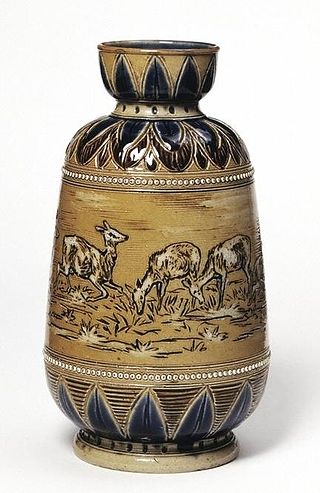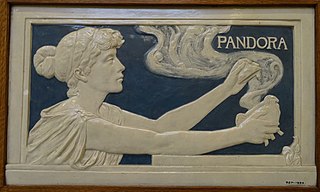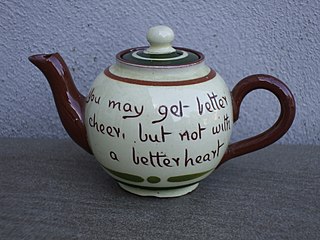
Hornsea Pottery was a business located in the coastal town of Hornsea in the East Riding of Yorkshire, England. They specialized in tableware with elegant contemporary designs.
North Dakota in the United States has been the scene of modern era pottery production using North Dakota clays since the early 1900s. In 1892 a study was published by Earle Babcock, a chemistry instructor at the University of North Dakota (UND) that reported on the superior qualities of some of the North Dakota clays for pottery production. The UND School of Mines began operations in 1898 with Earle Babcock as director. With the assistance of several eastern potteries, pottery made from North Dakota clay was first displayed at the 1904 St. Louis World's Fair.

Langley Mill Pottery was located in Langley Mill, Derbyshire on the Derbyshire – Nottinghamshire border. From its establishment in 1865 to its final closure in 1982, the pottery went through five distinct periods of ownership, producing a wide range of stoneware ranging from salt glazed ink bottles, utilitarian items and tableware to high quality and original art pottery.

Royal Doulton is an English ceramic and home accessories manufacturer that was founded in 1815. Operating originally in Vauxhall, London, and later moving to Lambeth, in 1882 it opened a factory in Burslem, Stoke-on-Trent, in the centre of English pottery. From the start, the backbone of the business was a wide range of utilitarian wares, mostly stonewares, including storage jars, tankards and the like, and later extending to drain pipes, lavatories, water filters, electrical porcelain and other technical ceramics. From 1853 to 1901, its wares were marked Doulton & Co., then from 1901, when a royal warrant was given, Royal Doulton.

Blue Mountain Pottery was a Canadian pottery company in Collingwood, Ontario, that operated from 1953 to 2004.

The Della Robbia Pottery was a ceramic factory founded in 1894 in Birkenhead, near Liverpool, England. It closed in 1906. Initially it mostly made large pieces with high artistic aspirations, especially relief panels for architectural use, but also ornamental vessels and plates, intended for display rather than use.

Mintons was a major company in Staffordshire pottery, "Europe's leading ceramic factory during the Victorian era", an independent business from 1793 to 1968. It was a leader in ceramic design, working in a number of different ceramic bodies, decorative techniques, and "a glorious pot-pourri of styles - Rococo shapes with Oriental motifs, Classical shapes with Medieval designs and Art Nouveau borders were among the many wonderful concoctions". As well as pottery vessels and sculptures, the firm was a leading manufacturer of tiles and other architectural ceramics, producing work for both the Houses of Parliament and United States Capitol.

Maling pottery was produced in the north east of England for just over two centuries. The name of the pottery derives from the French surname of Malin. The family were Protestant Huguenots who fled their native land in the sixteenth century to escape the threat of religious persecution. They settled in England and prospered in a variety of business enterprises including coal, shipping and timber. Somewhere over the centuries the name was anglicized by the addition of a final "g".

Stoneware & Co., which was previously known by various other names including the J. B. Taylor Company and Louisville Stoneware until sometime after its sale in July 2007, is a stoneware-producing company located in the Highlands section of Louisville, Kentucky. Founded in 1815, it is one of the oldest stoneware producers in the United States. It specializes in decorating its pottery with Kentucky Derby and Christmas themes, but it has other themes as well: Noah's Ark, Primrose, and Pear being examples. They also create personalized items. Besides pottery, they have made bird baths and bird feeders.

Dorchester Pottery Works is a historic site at 101-105 Victory Road in Dorchester, Massachusetts, a neighborhood of Boston. The Dorchester Pottery Works was founded in 1895 by George Henderson and made stoneware. The Dorchester Pottery Works closed in 1979. The building was designated as a Boston Landmark in 1980 and added to the National Register of Historic Places in 1985.

Haviland & Co. is a manufacturer of Limoges porcelain in France, begun in the 1840s by the American Haviland family, importers of porcelain to the US, which has always been the main market. Its finest period is generally accepted to be the late 19th century, when it tracked wider artistic styles in innovative designs in porcelain, as well as stoneware and sometimes other ceramics.

J.A. Bauer Pottery is an American pottery that was founded in Paducah, Kentucky in 1895 and operated for most of its life in Los Angeles, California. It closed in 1962.

Edwin Bennett, born in Newhall, Derbyshire, was an English American pioneer of the pottery industry and art in the United States, and founder of the Edwin Bennett Pottery Company of Baltimore, Maryland. Producing a variety of wares from the everyday to the fine and artistic, his company, originally founded in the 1840s as the Edwin Bennett Queensware Manufactory, continued in operation until forced to close during the Great Depression in 1936. Examples of Edwin Bennett pottery may be found in museums across the United States, including the Maryland Historical Society, the Philadelphia Museum of Art, the Metropolitan Museum of Art, and the National Museum of American History, as well as in private collections.

Ceramics in Mexico date back thousands of years before the Pre-Columbian period, when ceramic arts and pottery crafts developed with the first advanced civilizations and cultures of Mesoamerica. With one exception, pre-Hispanic wares were not glazed, but rather burnished and painted with colored fine clay slips. The potter's wheel was unknown as well; pieces were shaped by molding, coiling and other methods,

The Ridgway family was one of the important dynasties manufacturing Staffordshire pottery, with a large number of family members and business names, over a period from the 1790s to the late 20th century. In their heyday in the mid-19th century there were several different potteries run by different branches of the family. Most of their wares were earthenware, but often of very high quality, but stoneware and bone china were also made. Many earlier pieces were unmarked and identifying them is difficult or impossible. Typically for Staffordshire, the various businesses, initially set up as partnerships, changed their official names rather frequently, and often used different trading names, so there are a variety of names that can be found.

American art pottery refers to aesthetically distinctive hand-made ceramics in earthenware and stoneware from the period 1870-1950s. Ranging from tall vases to tiles, the work features original designs, simplified shapes, and experimental glazes and painting techniques. Stylistically, most of this work is affiliated with the modernizing Arts and Crafts (1880-1910), Art Nouveau (1890–1910), or Art Deco (1920s) movements, and also European art pottery.

Stangl Pottery was a company in Flemington, New Jersey, that manufactured a line of dinnerware and other items. The company was originally founded as Samuel Hill Pottery in 1814, until 1860 when it became Fulper Pottery. The name changed to Stangl Pottery in 1955. The company ceased production and closed in 1978, but the dinnerware is still prized by collectors. Pieces can be identified by the Stangl name on the bottom. The original Flemington, New Jersey, location and showroom was bought in May 2011 to make space for a restaurant, a studio, and an art gallery.

The original Castleford Pottery operated from c. 1793 to 1820 in Castleford in Yorkshire, England. It was owned by David Dunderdale, and is especially known for making "a smear-glazed, finely moulded, white stoneware". This included feldspar, giving it a degree of opacity unusual in a stoneware. The designs typically included relief elements, and edges of the main shape and the panels into which the body was divided were often highlighted with blue overglaze enamel. Most pieces were teapots or accompanying milk jugs, sugar bowls and slop bowls, and the shapes often derived from those used in contemporary silversmithing.

Torquay pottery or Torquay ware is pottery made in Torquay, Devon, England, using local clay, at one of fifteen or so local potteries chiefly serving the tourist trade, but also supplying high-end retailers such as Liberty of London.
Oregon Pottery Company was established in the United States at Buena Vista, Oregon, in 1866. The largest pottery business on the West Coast of the United States at the time, it produced stoneware jars, jugs, and sewer pipe between 1866 and 1897 in Buena Vista and Portland, Oregon.





















